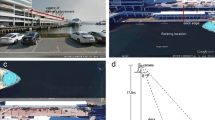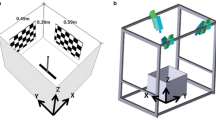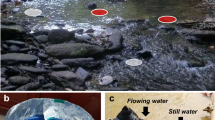Summary
Waterstriders on ponds and creeks compensate for displacement caused by wind or water current with periodical jumps against the direction of drift. This behavior is mediated by visual stimuli.
-
1.
Waterstriders are able to detect the direction and extent of their displacement on an artificial canal when visual cues are reduced to a single point-like light source above the upstream end of the canal. They adjust the frequency and direction of the compensatory jumps to keep their mean position on the canal constant. The mean amplitude of the jumps is constant and independent of the stream velocity.
-
2.
During drift compensation the light spot is kept in the frontal visual field at a fixed angle of elevation. This set angle differs among individuals and can be changed with time.
-
3.
The station-keeping ability can hardly be explained by a velocity servo system since there is no accumulating position error. The average compensatory movements are governed by a discontinuously working position servo.
-
4.
When the light spot is switched off, a few jumps are still performed. Jumps, therefore, are not triggered individually by visual cues. Waterstriders must possess an endogenous jump-generator.
Similar content being viewed by others
References
Cartwright BA, Collett TS (1982) How honey bees use landmarks to guide their return to a food source. Nature 295:560–564
Cartwright BA, Collett TS (1983) Landmark learning in bees. J Comp Physiol 151:521–543
Collett TS, Land MF (1975) Visual control of flight behaviour in the hoverfly, Syritta pipiens. J Comp Physiol 99:1–66
Collett TS, Land MF (1985) Visual spatial memory in a hoverfly. J Comp Physiol 100:59–84
Dahmen HJ (1991) Eye specialization in waterstriders: an adaptation to life in a flat world. J Comp Physiol A 169:623–632
Dahmen HJ, Junger W (1988) Adaptation to the watersurface: structural and functional specialization of the gerrid eye. In: Elsner N, Barth FG (eds) Sense organs: interfaces between environment and behaviour. Proceedings of the 16th Göttingen Neurobiology Conference. Thieme, Stuttgart New York, p 233
David CT (1986) Mechanisms of directional flight in wind. In: Payne TL, Birch MC, Kennedy CEJ (eds) Mechanisms in insect olfaction. University Press, Oxford, pp 49–56
Fahle M (1987) Visual hyperacuity: parallel versus serial processing. Invest ophthal Visual Sci 29:361
Fairbain DJ, Brassard J (1988) Dispersion and spatial orientation of Gerris remigis in response to water current: a comparison of pre- and post-diapause adults. Physiol Entomol 13:143–164
Hamann B, Langer H (1980) Sehfarbstoffe im Auge des Wasserläufers Gerris lacustris. Verb Dtsch Zool Ges 73:494–503
Junger W, Dahmen HJ (1986) Visually induced drift compensation in waterstriders. Verb Dtsch Zool Ges 79:217
Junger W, Dahmen HJ (1988) Waterstriders (Gerridae) use visual landmarks to compensate for drift on a moving water surface. In: Elsner N, Barth FG (eds) Sense organs: interfaces between environment and behaviour. Proceedings of the 16th Göttingen Neurobiology Conference. Thieme, Stuttgart New York p 35
Junger W, Varjú D (1990) Drift compensation and its sensory basis in waterstriders (Gerris paludum F.) J Comp Physiol A167:441–46
Kelber A, Zeil J (1990) A robust procedure for visual stabilization of hovering flight positions in guard bees of Trigona (Te-tragonisca) angustula (Apidae, Meliponinae). J Comp Physiol A 167:569–577
Pearson WD, Kramer RH (1972) Drift and production of two aquatic insects in a mountain stream. Ecological Monographs 42:365–385
Preiss R, Kramer E (1983) Stabilization of altitude and speed in tethered flying gipsy moth males: influence of (+) and (-) disparlure. Physiol Entomol 8:55–68
Schulz W (1931) Die Orientierung des Rückenschwimmers zum Licht und zur Strömung. Z Vergl Physiol 14:392–404
Waters TF (1972) The drift of stream insects. Rev Ann Entomol 17:253–272
Wilcox RS (1984) Male copulatory guarding enhances female foraging in a waterstrider. Behav Ecol Sociobiol 15:171–174
Zeil J, Wittmann D (1989) Visually controlled station-keeping by hovering guard bees of Trigona (Tetragonisca) angustula (Apidae, Meliponinae). J Comp Physiol A 165:711–718
Author information
Authors and Affiliations
Rights and permissions
About this article
Cite this article
Junger, W. Waterstriders (Gerris paludum F.) compensate for drift with a discontinuously working visual position servo. J Comp Physiol A 169, 633–639 (1991). https://doi.org/10.1007/BF00193553
Accepted:
Issue Date:
DOI: https://doi.org/10.1007/BF00193553




